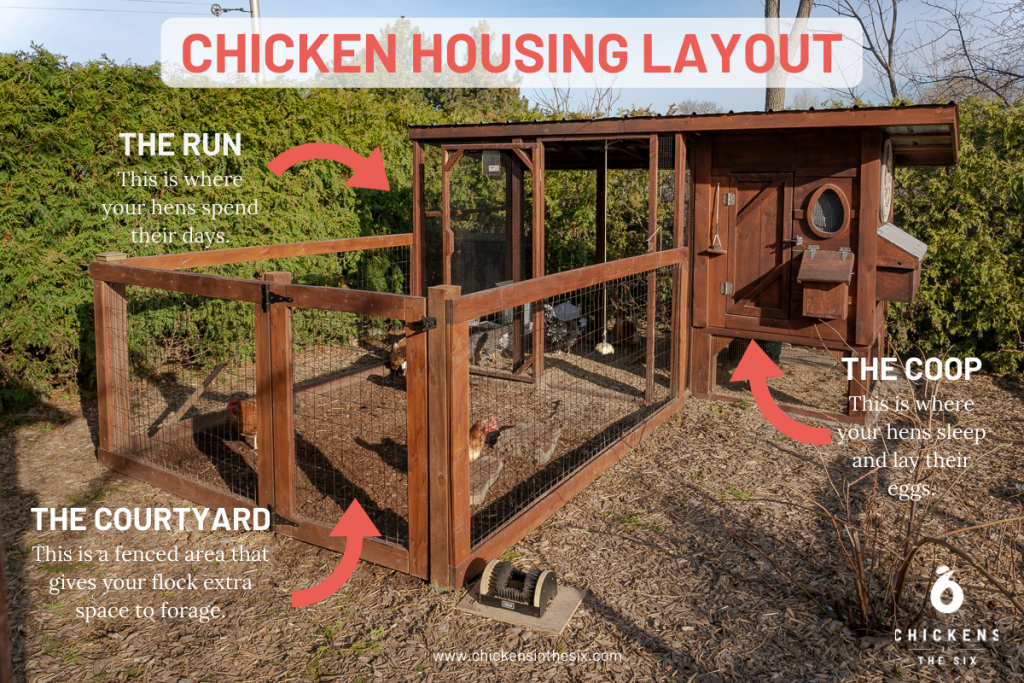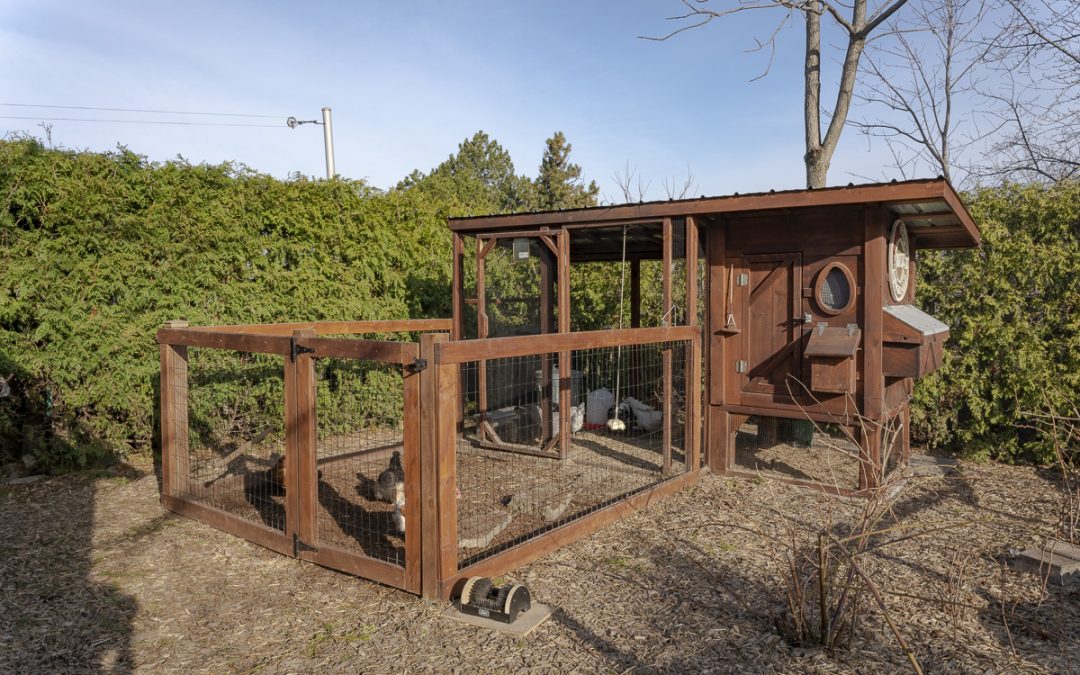The primary job of a chicken coop is to keep chickens safe from predators, pests and weather.
Chickens are especially vulnerable during the night due to their poor night vision, which unfortunately is also when their most dangerous urban predator is on the hunt – the raccoon.
Add to this our harsh Canadian winters and extreme temperatures throughout the year, and you’ve got to buy or build a coop that must stand up to all types of life-threatening dangers.
Chicken Coop Checklist
Here are the basics of a great chicken coop:
- Provide protection from all sides and from all predators and pests
- Protect from all types of weather including intense heat in summer
- Provide ventilation to release moisture in the winter and prevent frostbite
- Be draft-free at all times
- Provide roosts for sleeping and nesting boxes/area for egg-laying
- Must have a waterproof interior floor that can be washed and disinfected as necessary
- Must be easy to clean and access all parts
- Be pretty. We all love beautiful things, and a coop should be a jewel in your yard and not an eyesore.
How To Build A Great Chicken Coop
Chicken housing can be divided into three parts – the chicken coop, the run, and the courtyard.
The Coop
This is where your hens will spend the night sleeping and lay their eggs every morning. This has to be the most secure area for your flock because this is where they’ll be at their most vulnerable.
The Run
This is where your ladies will spend their days safely enclosed in an area that’s open to the elements, but still protected by hardware wire (small square wire…this is different from chicken wire.) This is where their food and water will be.
The run connects directly to the coop, and the hens can get into the run via a small door and down a ramp.
The run is a crucial part of the coop and can be built with simple and inexpensive materials if the coop you purchase doesn’t come with one already.
The Courtyard
This is extra if you have space for one. This is where your chickens can have lots of space to scratch and dig and enjoy the weather.
Some courtyards are attached to the coop, and some use a courtyard that can move around the yard. Mine is attached to the run and coop so that my hens can hide if they feel threatened and can put themselves to bed in the coop at night.
Below is a quick reference to chicken housing layout to show you everything I described above.

Chicken Coops Must Protect from Predators and Pests
No matter where you live, urban or country, there are several predators who will try to make a meal of your chickens.
Hawks Will Find and Kill Your Chickens
Even in the city of Toronto where I live, hawks find my backyard and try to get at my hens. They’ll circle from up high, swoop down, and rip a chicken apart in a few moments.
Chickens are experts at spotting flying predators. I’ll often find my hens with their heads cocked, necks stretched, looking up at a passing plane or harmless gull trying to determine the level of danger.
They’ll run and hide but are no match for a hawk or any other predatory bird. Having an adequate cover over the run to keep your flock safe during the day is crucial.
Racoons Will Kill Chickens for Food and Fun
At night, raccoons leave dusty paw prints all over my coop doors and latches as they try to get in and help themselves to one of my sleeping beauties.
They’re experts at opening doors, windows, hatches, latches, and whatever else you think is raccoon-proof.
Some years back, the City of Toronto spent millions inventing a raccoon-proof green compost bin. It had an impressive metal locking mechanism and was made of thick plastic.
They were opened by raccoons the very first night. Those that couldn’t open the bins chose to chew through them instead.
Raccoons have all night to study your backyard chicken coop and make every attempt to open it. If they get in, they’ll rip open a chicken, eat it, and move onto the next.
At that point, with a full belly, it will go on to kill the rest for fun.
I’ve woken up to find my beloved hens reduced to a pile of blood, guts and feathers.
I learned that doors must have latches that lock in some way. Only a locked latch is raccoon-proof.
Since raccoons will also dig under the coop to get in, the perimeter of the coop must have either one foot of protection around it, or directly under it. Buried chicken wire will do the trick, as will paving stones or flagstone around the perimeter of the coop.
Locking in your chickens at night, every single night, must be your top priority. Otherwise, you’ll wake up to the same gruesome scene I have in the past.
If You Build It, Rats Will Come
And then there’s the dreaded rat that will eat and drink their fill, poop all over the run, make a nest in the bedding, and spread lice, mites and disease.
A desperate enough rat can kill a chicken, but chickens are also experts at killing (and eating) rats when given a chance.
Rats aren’t a direct threat to chickens, but the diseases they’ll bring into your chicken coop sure is.
Burying hardware wire around the perimeter at least a foot wide or deep will help stop rats from tunnelling underneath. You can also bury heavy gauge chicken wire under your run if it’s a small area.
Keep all food in rat-proof metal bins. I use a large trough-like metal feeder with a lid that opens only when a chicken steps on the pedal in the front. Once the hen steps off, the lid slams closed.
My chickens got the hang of using it very quickly, and now rats are no longer an issue in our coop and run.
Unfortunately, the only way to permanently deal with rats is to trap and/or kill them. It’s unpleasant business, and I truly wish there was a better way. If there is, I haven’t found it yet.
Wild Birds Will Pass Diseases to Your Backyard Chickens
Wild birds, like rats, are pros at finding sources of food. And chickens are pros at throwing their feed on the ground no matter what kind of container you use.
As soon as one wild bird is able to eat from your coop, their dozen or so friends will soon follow.
With them will come lice, mites, and deadly bacteria and viruses in their droppings.
I’ve had sparrows squeeze through chicken wire to get in and out of my coop!
Making sure you use the tiny square hardware wire in your coop will keep both wild birds and mice out. Feed should not be kept in an open container or thrown on the ground if in an open area.
If you’d still like to welcome wild birds into your yard, set up bird feeders with their favourite seeds far from your coop.
Chicken Coops Must Withstand and Protect From All Weather
No one wants to build or buy a new coop year after year. But this is what you’ll be in for if you purchase one of those very cute, but very weak coops online.
I’m sure by now you’ve seen them…they look like gingerbread houses or little cottages. They’re made to melt your heart and imagine a storybook life with your hens.
Trust me, that’s not what you’ll get.
Most of those chicken coops aren’t built any better than a child’s playhouse meant to last a few seasons. They’re made with thin, flimsy wood. Their paint is not weather-proof or waterproof.
And, they’re tiny! They’ll be almost impossible to clean when you can only reach one arm in at a time. Those that have runs attached to them, a person cannot stand up inside.
Are you willing to crawl on mud and chicken poop to replace food, water, grab an egg that was laid outdoors, help an ailing chicken, etc.?
Good Chicken Coop Design
If a coop is made from pine, you should be able to stain or paint it with outdoor paint to protect it. Ideally, a coop should be made from pressure-treated wood for maximum longevity.
The coop should be raised off the floor to provide extra protection from the cold ground in the winter, and to allow you to clean it out and collect eggs without having to bend down.
The run should be built tall enough that you can walk inside. You’ll need to every day to replace food and water, and at least once per week to rake it.
I personally think that my coop is ideal in every way. Feel free to copy the design if you’d like!
Otherwise, you can source out many great designs online.
If you’re going to purchase a ready-made coop, keep in mind what I described above. Coops that meet my standards are available ready-made, but they’re harder to find and considerably more expensive.
Another option is to purchase a shed and convert it into a chicken coop and add a run. Have a look at that DIY option online.
Make Your Chicken Coop Pretty
I can’t stress how important this is. Your chicken coop should complement your yard as much as any other structure or landscaping feature.
We’re all attracted by beautiful things. Your coop should also be beautiful.
Once it has provided everything your flock needs, it can also put a smile on your face every time you look at it.
Taking care of chickens is dirty, and sometimes ugly work.
Having a lovely, freshly painted, gorgeous coop helps. Landscaping around it, or hanging flower boxes on it makes it darling.
This may seem unnecessary and silly, but trust me that on those cold, rainy days, meeting your lovely ladies in their beautiful coop helps remind you that it is all worth it!


